
36 minute read
Office space sector in Poland in the face of coronavirus
The coronavirus pandemic has significantly influenced the preferences of office tenants, and the interest in flexible spaces in Poland does not slow down, it can even accelerate. This is just one of the takeaways on the future of offices from the debate entitled “Impacts of coronavirus on the office space market in Poland: The broker’s angle.”
The event was hosted by Mindspace, a global operator of boutique flexible workspaces, included representatives of advisory agencies such as JLL, CBRE, Colliers International, and Cushman & Wakefield.
As Yotam Alroy, Co-founder and CBO of Mindspace, said at the beginning of the debate, “The COVID-19 pan demic has caused significant changes in both our lives and work environment. As a result of the coronavirus, most of us started working remotely. Therefore, a number of real property players - advisory agencies, owners, operators and office managers - have been asking themselves questions about the future of offices for several months now. Our observations show that during the pandemic, many compa nies began to treat flexible office space as an alternative to a traditional office. This is evidenced, among other things, by the growing interest among potential clients in spaces offered by Mindspace. This trend is also visible at our War saw branch, which strengthens my belief that the demand for flexible office space will continue to grow in Poland. We are forecasting a marked shift from the traditional lease model to flexible partnership-based agreements between operators and building owners. We also expect a major consolidation in the industry, i.e. a number of mergers and acquisitions. In our opinion, this will happen over the next 12 to 24 months.”
During the meeting, all speakers agreed that office tenants’ preferences were subject to change due to coronavirus. The experts’ observations show that numerous companies have already made or are considering a decision as regards moving some of their branch offices or even head offices to flexible space with a view to optimizing their expenditures and the possibility of reducing or increasing the leased space at any time, without the need for long-term commitments.
Adam Lis, Flexible Office Solutions Manager at JLL, commented: “Undoubtedly, in these times of pandemic, the flexibility of lease agreements has gained increasing importance, also for the SME sector and corporate clients. In these rather unpredictable times, short-term agreements, often with one month’s notice, have proved to be an ideal solution and can represent a lifeline for many companies. This illustrates the value of flexibility for tenants, both small and large, and strengthens the position of flexible solutions in the commercial real estate property market.”
Yotam Alroy, Co-founder and CBO of Mindspace

The “Impacts of coronavirus on the office space market in Poland: The broker’s angle” debate.
Adam Lis continued: “Landlords on the ‘traditional’ office market have been learning from flexible space operators about how to take care of their tenants and how to meet their ever-growing needs. Flexible space is a sign that the landlords’ perspective is changing from tenant-centric to human-centric. All of us, especially office workers, could benefit from this change.”
Konrad Szaruga, Head of Flexible Workplace at CBRE, remarked: “COVID-19 has left its mark on all segments of the real property market. As far as its impact on the market of flexible office space is concerned, we can see the strengthening of the current trend that it is an excellent solution for new companies, especially for foreign entities—taking into account a time horizon spanning from several months to two years. Secondly, we observe that flexible spaces are gaining ground among companies seeking both permanent headquarters and a temporary office to meet short-term needs. Here, we see very clear interest of companies that are unwilling or unable to work from home, but at the same time are currently unwilling to make long-term decisions due to the unstable market situation.”
In turn, according to Mikołaj Niemczycki, Capital Markets Associate at global real estate services firm Cushman & Wake field, the growing interest of office tenants in flexible space is mainly due to the changing expectations of their employees. As Niemczycki explained, “The pandemic has proven that home office is a solution that works not only temporarily. However, the natural challenges of working from home make you want to return to the office. What is more, the expectations of em ployees have changed, and today they expect greater freedom of choice in the place and form of work. In the coming years, the winners will be those employers who provide adequate infrastructure for employees who prefer to work from home or decide to open satellite offices, on the outskirts of cities or in residential areas. It is in these locations, offered on flexible lease terms, that we see the greatest potential for further devel opment of the flexible office segment. Flexible offices can fill an important gap, responding to the new needs of employees.”
Renata Hartle, manager of Flex Office Strategy & Technology Solutions at Colliers International, stressed during the meeting that the coronavirus had significantly influenced not only employees’ expectations for their work environment, but also the daily operation of office facilities: “The COVID-19 pandemic definitely accelerated the implementation of technology-based solutions on the real property market. Desk reservation systems and occupancy rate analysis had been seen as a gadget in recent years. Today, however, they are becoming the most sought-after solutions to support returns to offices. At the top of the popularity list there are also technologies supporting contactless moving around within the space and flexible car park management.”
Michał Kwinta, Senior Community Manager at Mindspace Koszyki, said: “In fact, the coronavirus has significantly impacted workplaces. Although our strategy has not changed - we are still putting an emphasis on commercializa tion—today we have an additional task. We have to ensure Mindspace users a completely safe place. In the past months, we have done a lot of work at Mindspace Koszyki to adapt its space as quickly as possible to the new reality. Our priority has been to provide a healthy and professional workspace to our members and their guests. Today, I can truly confirm that flexibility is what we are best at.”
About Mindspace
Mindspace is a global provider of boutique flex spaces redefining the workplace experience for companies of all sizes. Their beautifully designed spaces, personalized level of service and carefully curated events foster enhanced employee engagement and a strong sense of community, accommodating the way people now work, learn, innovate and grow.
Mindspace has a total of 31 locations in 16 cities and 7 countries across Europe (Poland, Germany, Romania, UK, Netherlands), the United States and Israel. Members of the Mindspace community can use any other location around the world at no additional cost.
The Warsaw branch of Mindspace is an office complex directly adjacent to Hala Koszyki. The offices are located on four floors of the office building at ul. Koszykowa 61 and on two floors in the tower at ul. Koszykowa 65. In total, 750 members can work in both locations, in nearly 5,500 m 2 .
GREAT GEAR
1
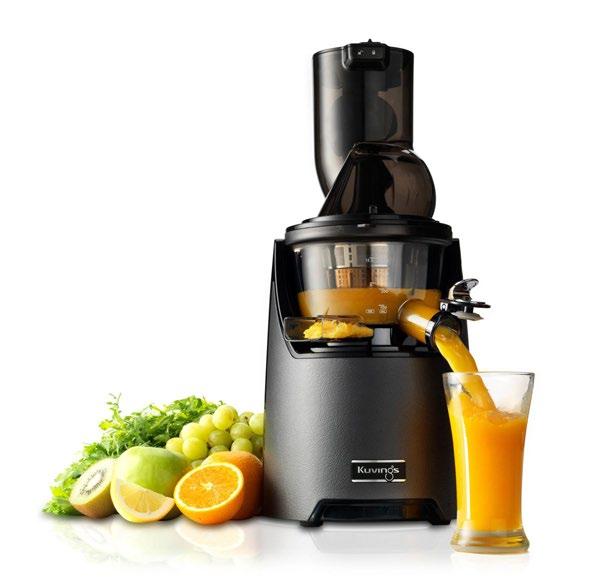



2
3
1/ Kosmonauta Watch The collection offered by Polish watch company G. Gerlach includes the Kos monauta (Cosmonaut) model. This outstanding piece comes with an old-fashioned LED display. In the 1970s this watch was made by Polish electronic firm Unitra Warel from Warsaw, and was very hard to obtain on the Polish market at the time. It went down in his tory thanks to Poland’s first astronaut, Mirosław Hermaszewski, who wore it in space. The present-day version of the Kosmonauta model is inspired by the old one, but regardless of this inspiration it features a modern style and top quali ty. The stainless steel case and bracelet provide a nice contrast to the dark red sapphire glass. The electronic part of the watch was made specially for this out standing model.
2/ Continental PremiumContact 6: “Best in Test” ”Highly balanced performance. Dynamic handling with precise steering, short braking distances, very high mileage and high economy,” is how German automotive magazine Auto Bild describes the strengths of the PremiumContact™ 6. The Continental summer tire came first with a “very good” rating and was the only product to receive the “Best-in-Test” and “Eco-Champion” titles for the most profitable product. In the world’s largest summer tire test, the experts tested 50 tire models that fit many mid-range and higher-class cars. The Continental PremiumContact 6 is produced in a very wide range of sizes and is approved for speeds up to 300 km/h.
3/ Juicer Kuvings Evo820 Plus Evo820 Plus is cutting-edge and the most durable low-speed juicer on the Polish market. Practical casing allows to reduce the time of preparation healthy juice. Be yond functionality it has elegant appearance and it will be a stylish addition for every kitchen. Enclosure is available with four colors - white, “champagne”, grafit and red. Kuvings brand received many designers rewards for this model of juicer. Juicer Evo820 Plus gained recognition of Polish customers. Kuvings won Golden Consumer Laurel in category of juicers five times in a row.
GEAR
4

6
5


4/ Realme X50 Pro The Realme X50 Pro is a smartphone with a 6.4” screen and resolution of 2400 x 1080 pixels. The super Amoled panel is protected by Gorilla Glass 5. The device has a camera with four lenses with resolutions of 64, 12, 8 and 2 Mpix. What distinguishes the X50 Pro most is its 5G network support, the 65-watt charger that will charge a 4200 mAh battery in 35 minutes, and the use of a Snap dragon 865 5G processor, which allows you to accelerate graphics by 25% while saving up to 30% of power compared to earlier-gen eration processors. The Realme X50 Pro smartphone has two SIM card slots.
5/ Grill without smoke LotusGrill brand is thinking about people who don’t want or just cannot use tradi tional barbecue and proposes innovative solution. It’s multifunctional device for healthy food from the barbecue. Ecolog ical grill is powered by coal and there is no smoke. You can use this device on your balcony or terrace, camping or even on boat. You don’t need unusual fuel like charcoal or briquette to run the bar becue. It’s very easy to fire up and keep it clean for most of time. It is equipped with function of temperature adjustment and air blowing. Barbecue doesn’t release carcinogenic substances. The main advan tage of this device is that you can easily put it in the middle of table with no conse quences. There’s nothing more satisfying than preparing dishes with your friends. The customer receives a 5 year guarantee so it’s investment for a long time. Lotus Grill is available in many colors, sizes and with a lots of accessories.
6/ Woodpecker Woodpecker Q3 and Q7 plasma air purifiers operate on the principle of air decontamination. They use high-energy plasma technology in the process of continuous disinfection, thus ensuring pathogen-free air. They work throughout the room, not locally as with germicidal lamps using UV radiation. Plasma purification technology is 6-8 times more effective than traditional electrostatic disinfection. The Q 3 plasma cleaner will quickly and most effectively re move bacteria and viruses in areas up to 40 sq. m in size, while the Q7 model is ideal for sterilizing rooms up to 110 sq. m.
THE
A journey to pre-war center of Jewish life
The exhibition “Here is Muranów” at the POLIN Museum of the History of Polish Jews presents the unique, multi-layered history of the Muranów residential district of Warsaw and reveals unknown dimensions of the past, present and future of the city and its residents. It takes visitors on a stroll in the former Northern Quarter which was the center of Jewish life before World War Two, when the Polish capital was home to the largest Jewish diaspora
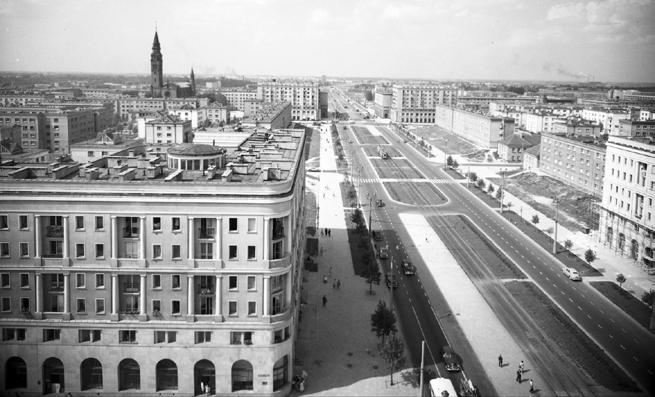
in Europe. During the war, the Nazi Germans turned it into the largest ghetto in occupied Europe, and later razed it to the ground.
The story of Muranów is told through the experiences of its inhabitants from four periods: until 1939, during World War II, during the rebuilding of the dis trict, and nowadays.
“The exhibition looks at thirteen selected locations in the district, some of which still function in an almost un changed form, and some of which no trace remains,” says Kamila Radecka-Mi kulicz, curator of the exhibition. It shows everyday objects, photos, postcards, press articles and film recordings illustrating the history of individual places in the periods mentioned. “We tell about each of these places in a form that resembles the adver tising posts that have not changed since the 19th century, thanks to which we can look into the history of the city, winding or unwinding the clock of history,” Radec ka-Mikulicz says.
The visitors are also able to walk around the installation evoking the spirit of pre-war Nalewki, a vibrant commercial street, comparable to today’s Marszał kowska Street in Warsaw, with its hustle and bustle and a variety of stores, goods and services available. They can learn about the dramatic fate of Jews impris oned in the Warsaw Ghetto established in the district. They can find out how the urban planners reconstructing the capital city envisaged a new Modernist housing estate on the rubble of pre-war Warsaw, and even how children played in the court yards of postwar Muranów.
BUZZ
Art of humor
“Crack Up-Crack Down”, an exhibition at the Ujazdowski Castle Centre for Contemporary Art is a global overview of satire as a graphic genre, showing how humor has evolved over last decades with political shifts and technological development.
Its first edition was presented at the 33rd Biennial of Graph ic Art in Ljubljana. The Warsaw project was expanded to include new Polish contexts.
Comedic expression is known to bloom particularly under authoritarian regimes, as was the case with the rich tradition of communist humor in Cen tral and Eastern Europe, or the many examples from the Middle East. Satire can also be a tool of ideology even if it is well-fitted to unmask the mechanisms of authority. In the times of post-truth, it becomes a litmus paper of the public mood.
Put together by the art collective Slavs and Tatars, the exhibition show cases both historical and contemporary works, including bantering drawings, activist interventions, ironic memes, satirical magazines, and academic elab orations.
Slavs and Tatars have not reduced graphic art to the mere role of a “me dium” but have granted it agency. At the Ujazdowski Castle Centre for Con temporary Art, the collective presents a broad spectrum of works by artists from Slovenia, Ukraine, Georgia, Bulgaria, but also China, Iran, UK, and the US.
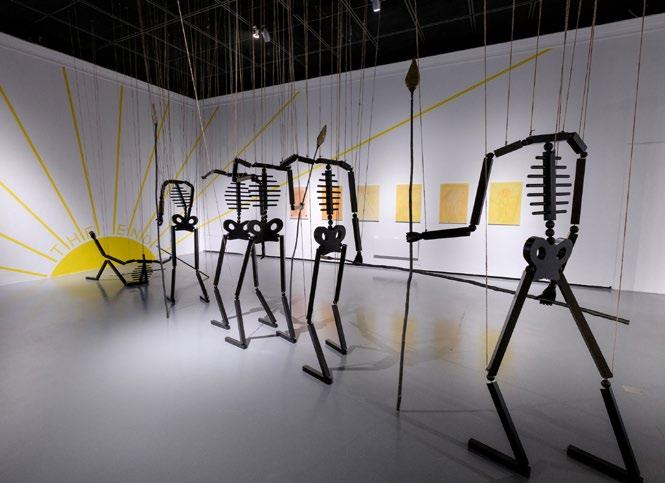
Polish artists include Bolesław Chrom ry, Rafał Dominik, Jana Shostak and Jacqueline Sobiszewski. Until October 11.
Cult comic book made into a musical
Warsaw’s Syrena Theater is staging a new musical theater performance entitled ‘Captain Żbik and Yellow Saturator’. The production is based on a Polish comic book series, very popular in the 1970’s, about the adventures of a crime-solving officer of Milicja Obywatelska, the national police organization in the PRL (Poland under communist regime).
The concept and script of Captain Żbik, specially commissioned by the Syrena, was written by an acclaimed musical theater director Wojciech Kościelniak. Praised by critics for creating his own style of musical theater and lifting the Polish musical to a high artistic level, he is also the director of the performance.
Kościelniak previously collaborated with Syrena when staging a very successful Hallo Szpicbródka (Hello, Fred the Beard), a music theater version of the Polish movie which was a big hit in the 1980s.
Captain Żbik, a two-act show is not only pure entertainment full of great music and dance but also has a cognitive value. It shows, in an attractive way, Warsaw in the 1970s and life in Poland under the communist regime.
The style of acting, costumes and set design draw from the conventions found in the film “Grand Budapest Hotel”.
Dynamic music inspired by music style of the 70s was written by a jazz pianist, composer and arranger Mariusz Obijalski.
The set and costumes were designed by Anna Chadaj and the choreography by Ewelina Adamska-Porczyk.
The cast includes Maciej Maciejewski/ Łukasz Szczepanik as Captain Żbik, Iga Rudnicka, Ada Szczepaniak, Albert Osik Tomasz Więcek, Barbara Garstka and Karolina Gwóźdź.

Restoring memory of Polish-Soviet War
The exhibition “1920 War: a Photographic Account” at the National Museum in Warsaw, was prepared on the occasion of the 100th anniversary of the Battle of Warsaw which resulted in a decisive Polish victory over Bolsheviks in 1920 during the Polish–Soviet War. It is an attempt to restore the collective mem ory of the image of that dramatic period.
The photographs displayed at the National Museum depict everyday life during the war, private and official, taken by professional photographers and amateurs, by military and civilians.
Photographic testimonies of the Polish-Bolshevik war have not been recorded in the minds of Poles, although many photos commemorating the events of 1919-1921 have survived, according to Karolina Puchała-Rojek, curator of the exhibition.
“For the first time in such a large selection, original photos and albums from the period will be shown to the public. We are showing what are almost exclusively period prints, exposed and developed almost as long ago as the events they represent occurred. Their condition and format bear witness to the technological advancement of the era’s photography. For the first time in an exhibition space we are also presenting photo-books in their original form,” she says.
All these accounts comprise a catalogue of familiar themes of war photography: portraits of soldiers, both men and women (who for the first time were formally allowed to fight), scenes of recruitment, exercises, marches and regroupings, lulls and daily life on the front, and finally the consequences of war - wreckage, prisoners, the wounded, the dead, but also scenes of welcoming, of medal-awarding and commemoration ceremonies.
Among photographic accounts of the conflict there are propaganda pictures, taken for the deliberate and explicit pur pose of being published in the press, and private ones, originally not meant to be viewed outside the photographer’s circle

of family members and friends. Examples of the former are on show in unusually high numbers, as an extensive selection from the Warsaw Photographic Agency’s collection of photographs documenting the events of 1920, acquired by the National Museum in Warsaw as early as May 1921.
Film footage, both staged and documentary, features importantly in the exhibition scenario. Excerpts from various 1920s movies are shown, including the recently restored full-length documentary, Polonia Restituta (1928). Until November 15.
The title of the exhibition “Far Too Many Stories to Fit into so Small a Box” was inspired by the inscription that Lawrence Weiner placed on the facade of the Ujazdowski Castle in the mid-90s. His sentence, which sounded slightly different: Far Too Many Things to Fit into so Small a Box, became an unofficial motto of the institution which organizes dozens of events every year.
The first director of the CSW’s Wojciech Krukowski created an original formula of the institution based on a multidisciplinary approach to art. Contemporary artists he invited made the place become a true nucleus of alternative art movement.
The Dutch duo based their concept of the jubilee exhibition not only on archives and works from the center’s collection, but also on a very extensive performance To mark the 30th anniversary of the Center for Contemporary Art - Ujazdowski Castle (CSW) in Warsaw, the Dutch artistic duo Bik Van der Pol created a project telling about the unique character of this place.
program, prepared especially for the occasion.
The performers tell stories of individual objects of art. The performance script is dynamic and the audience can modify it according to their own impressions, experience, memories of the CSW’s beginnings, exhibitions, artists and their works.
The birthday project features objects, installations, and videos of artists such as Nan Goldin, Natalia LL, Oleg Kulig, Joanna Rajkowska, Zbigniew Libera, Alina Szapocznikow, Martin Creed, Jenny Holzer and many others.
Some, such as blue transparent foils on the windows of David Hammons from the 2000 Real Time exhibition again add a mysterious glow to the gallery interior.
Some, like messages written in pencil on the walls by Yoko Ono during the performance accompanying her 2008 exhibition are still readable and say a lot about the place. ”Many rooms, many dreams, many countries in the same space.”

Man of La Mancha at Dramatyczny theater Warsaw’s Dramatyczny theater is staging a musical Man of La Mancha, inspired by Cervantes’ epic 17th-century novel, Don Quixote.
ABroadway hit composed Mitch Leigh, with a book by Dale Wasserman and Lyrics by Joe Darion is one of the most touching stories about faith in ideals, selfless sacrifice, the power of imagination and the right of every human being to freedom and dreams. Its unique charm is created by music in the rhythms of Andalusian flamenco and melodious songs by Darion.
Man of La Mancha tells the story of the fearless Don Quixote as a play within a play, performed by Cervantes and his fellow prisoners, as he awaits a hearing with the Spanish Inquisition. The noble and righteous knight sets off on a jour ney carried by a desire to help others and defend the weak. Experiencing occasion al failures, he is mocked by others, who see him as a madman. Faithful to his be liefs, however, he does not leave the once chosen path.
The question remains who is mad, the one who wants to fix wrongs or the one sees the world as obvious?
Leigh’s musical has been enjoying great success for years and is played all over the world, thanks to the timeless wisdom of Cervantes and beautiful music.
The original 1965 Broadway production ran for more than 2,000 performances and has been revived four times on Broadway, becoming one of the most enduring works of musical theatre.
Warsaw cast includes Modest Ruciński as Cervantes / Alonso Quixano/ Don Quixote, Krzysztof Szczepaniak as Squire / Sancho Pansa and Anna Gajewska as Al donza/Dulcinea, as well as Tomasz Budyta, Waldemar Barwiński, Anna Gorajska and Mariusz Drężek.
The music is performed live by the or chestra conducted by Adam Sztaba, the performance’s music director. The set and costumes were designed by Ewa Gdowiak and the choreography by Anna Iberszer.
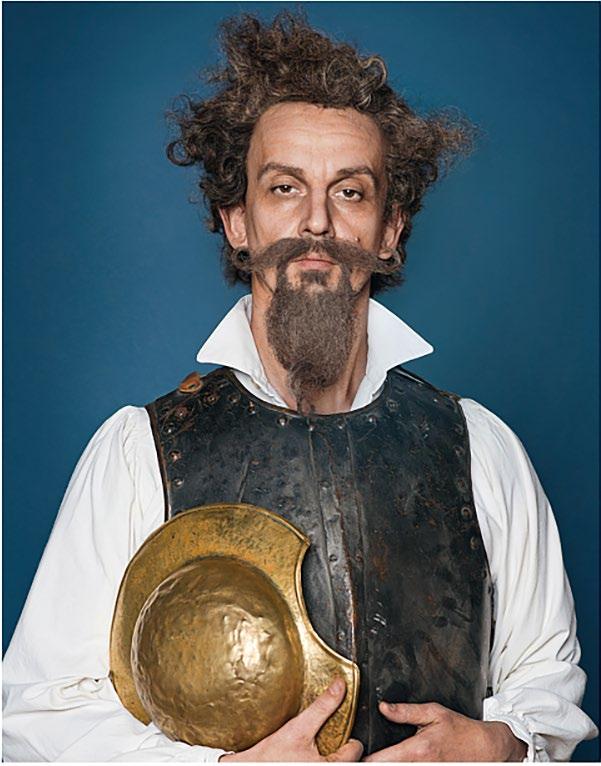
Original, Replica or Copy?
Leonardiana in Polish collections,” exhibition at the Museum of King Jan III’s Palace in Warsaw-Wilanów is part of the “What’s What: Original, Replica, Copy” cycle. Organized in co operation with the Leonardo da Vinci Society and after consultations with the National Gallery in London as well as many other museums around the world it aims to show the “myth of Leonardo” in the context of collectors’ interests and fascinations.
Referring to the heritage of Leonardo da Vinci, the exhibition presents 39 artistic objects from various Polish col lections, including six paintings as well as graphic works and drawings corre sponding in terms of form and content with The Savior of the World (Salvator Mundi) painting from the museum’s collection.
The painting was in 1798, the time of purchase, considered to be the origi nal work of Leonardo da Vinci. Today, more than a dozen paintings of such composition, created in the 16th cen tury, are known and the one Wilanów has long been a subject of historical and conservation research carried out in cooperation with research centers in Poland and abroad.
A separate element of the exhibition is the demonstration of technologically advanced methods and results of image research and ways for assessing their age. Until October 15.
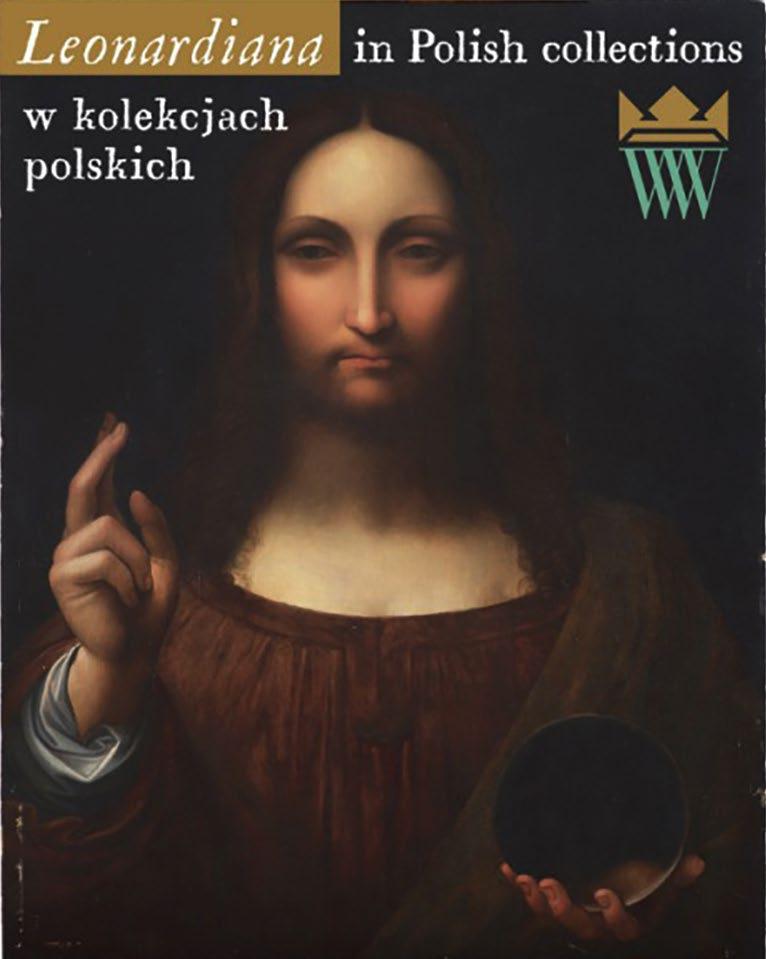
Warsaw Chamber Opera stages Piazzolla’s masterpiece
„Maria de Buenos Aires,” a tango operita with music by Astor Piazzolla and libretto by Horacio Ferrer premiered at Warsaw Chamber Opera’s Basen Artystyczny Stage.
This arguably Piazzolla’s greatest masterpiece is a surreal spiritual journey through the world of hu man emotions and passions, set to the beat of the Nuevo tango.
It tells the story of a woman from Buenos Aires called Maria who, en chanted by music and tango passes into the dark side. The protagonist is a per sonification of both love and the denial of human feelings.
The plot comes full circle and everything that happens between the birth and death of the heroine is a reflection of the world with its bright and dark sides, beauty and evil, purity and scandal.
The performance is a real feast of rhythm, sensual dance, trembling emo tions and human weaknesses translated into music notes and phrases. The music enchants the audience with its compel ling rhythm and provokes a symbolic look into the depths of human feelings.
A team of renowned producers and artists responsible for the project in clude opera director Michał Znaniecki, stage designer, Luigi Scoglio and the sensational Tango Attack ensemble un der the baton of Hadrian Tabęcki.
Cast: Marek Kaliszuk/Darek Niebudek (El Duende), Alicja Węgorzewska/Gosha Kowalinska (María, La Sombra de María), Mikołaj Adamczak (Tre Voci)/Hubert Stolarski (La Voz de un Payador/ Una Voz de Ese Domingo), Miłosz Gałaj (Tre Voci)/Andres Martorell (Porteño Gorrión con Sueño/Analista Primero), Wojtek Soko Sokolnicki (Tre Voci)/Paweł Strymiński (Ladrón Antiguo Mayo).

Meet the designer of Poland’s memorable logo The Poster Museum in Warsaw Wilanów is hosting a retrospective exhibition of works by Jerzy Treutler, a recognized and award-winning Polish graphic artist and designer.
Treutler’s name was popularized in 1958 when he created the iconic logo of Moda Polska, the stateowned fashion company, widely known as “swallow.” This sign has been cited as an example of one of the best trademark design in the history of Polish applied graphics.
The present exhibition is the first comprehensive presentation of Treutler’s artistic output. It showcases 400 of his works including 130 film, exhibition and circus posters, book layouts and cover designs, photographs, press illustrations, satirical drawings, sketches, bookplates and private documents. “It is an overview of the achievements of a versatile, disciplined artist, but creating with energy and enthusiasm, ‘with the cheek‘ as the artist himself used to say, says Ewa Reeves, the curator of the exhibition.
In her opinion, the secret and power of this “excellent draftsman’s work” lies

in the “extraordinary line” he used and therefore “drawing is the compositional axis and an idea organizing the present exhibition.”
Treutler’s works has been presented at collective exhibitions of Polish posters in over 20 countries in Europe and beyond. Until November 15.
Discomfort of closeness in focus
The recently-opened exhibition Frowst at Zacheta National Gallery of Art is Poland’s first comprehensive monographic presentation of Joanna Piotrowska’s works from the past few years.
Having exhibitions in leading art institutions all over the world (including Tate Britain in London or MoMA in New York) to her credit, Piotrowska is today one of the most important Polish artists of the younger generation.
In her staged photos and videos, the artist focuses on exploring human rela tionships and their bodily expression. She looks at characters entangled in the context of social institutions, struggling with manifestations of power, emotional dependencies and the violent element of human nature. She is interested in the family, security, home and homeless ness, the position of a woman and the psychology and politics of girl rebellion, as well as the human need to control and dominate animals. Her black-andwhite, handmade, gelatin silver prints and videos on 16 mm tape are more of a record of performance or spectacle than a documentary.
The title of the exhibition was tak en from one of Piotrowska’s first photographic series (2013–2014), which brought her international recognition. “Frowst” (in other words, suffocation, mustiness) brings to mind the dense air of an unaired-out apartment, saturated with complicated family relationships. The series was inspired by the pseu do-scientific, manipulative method of “organising tangled and broken family ties” developed by German psychother apist Bert Hellinger. Based on the observation of body positions and gestures, the tense, staged photographs showing family systems of dependencies were created.
Under the influence of texts by the American feminist and developmental psychologist Carol Gilligan, who dealt with the issues of women’s voice and re sistance, a series of photographs (2015) was created, presenting teenage girls in poses taken from self-defence textbooks. These works refer to the ubiquitous, structural and physical violence against women, but they are also a story of a re bellion of women and girls against a culturally sanctioned narrative that disciplines women.
The exhibition presents the latest se ries documenting cages and enclosures for animals in zoos, arranged on the model of human residential architecture (2019). These photographs reveal the dominance of humans over the animal world, the need for control, the lust for power and the fear of the Other. Pi otrowska also started to photograph objects used for playing and stimulating animals (2019) which look like instruments of torture, medical instruments or erotic fetishes.
The exhibition closes with a photo graphic project from 2017. Piotrowska asked her friends from Warsaw, Lon don, Lisbon and Rio de Janeiro to build hiding places in their apartments, safe, intimate shelters. The impermanent con structions depicted in the photographs speak of the temporality and conven tionality of the home, understood both as a building and as a system of inter personal relations. The work combines the innocence of children’s games with the gravity of the problem of seeking physical and emotional refuge. The art ist touches upon the topic of safety and lack thereof, but also upon the fragility of material comfort. It turns out that it is impossible to build a true refuge from the piles of things we own. Until December 6.
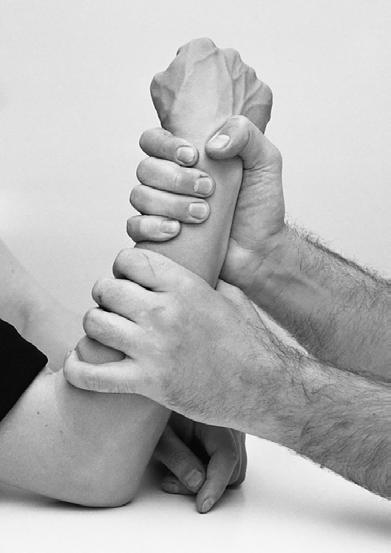
Daily life in Warsaw Ghetto in images
More than 70 archival images with historical commentaries, presented on 20 boards, show the “normal” day in the life of the Warsaw Ghetto, the largest ghetto in all of Europe established by Nazi Germans in the fall of 1940.
The displayed photo reproductions come from the collections of the most im portant institutions conducting research on Holocaust, including the Washing ton-based United States Holocaust Memorial Museum, Yad Vashem in Jerusalem, the Jewish Historical Institute, as well as from the German Bundesarchiv and the Austrian National Library.
The exhibition showcases portraits and general plans with daily crowds in the streets and markets of the ghetto, people organizing self-help, creating art, working and praying.
“We avoid drastic images in order to show our heroes in a dignified way. We see them not only as victims, but, first and foremost, people who, despite the extreme conditions, are trying to maintain the last remains of normal life,” says the curator of the project, Rafał Kosewski.
In his opinion, “focusing on the faces, sometimes smiling, hoping to survive, sometimes full of reflection, as if having a sense of impending death, emaciated, starved and desperate, enables the contemporary audience to have a deep, empathetic contact with Warsaw Jews, who in September in 1939, constituted a third of the capital’s population. “
A large part of the photographs presented were taken by the German soldiers of Propaganda-Kompanie 689, German Army propaganda unit stationed in The open-air exhibition “One in Three” at the Grzybowski Square prepared by the Warsaw Ghetto Museum on the 77th anniversary of the outbreak of the Warsaw Ghetto Uprising and the 80th anniversary of the closing of the ghetto borders, which falls in November 2020.
Warsaw in 1943 - Albert Cusian, Erhard Josef Knobloch and Joe Heydecker - documenting the suppression of the Warsaw Ghetto Uprising. Despite the fact that the vast majority of these photographs were taken for the purposes of propaganda, they also document the misery of the Ghetto.
In addition to the scenes from everyday Ghetto life, the exhibition presents major historical events, such as, the so-called Grossaktion Warsaw (the Nazi code name for the deportation and mass murder of Jews from the Warsaw Ghetto beginning 22 July 1942) and the Uprising of 1943. It also discusses various examples of social and economic life, from the organisation of home committees or charitable institutions to smuggling - an important element of the Ghetto’s economy. Until November 30.
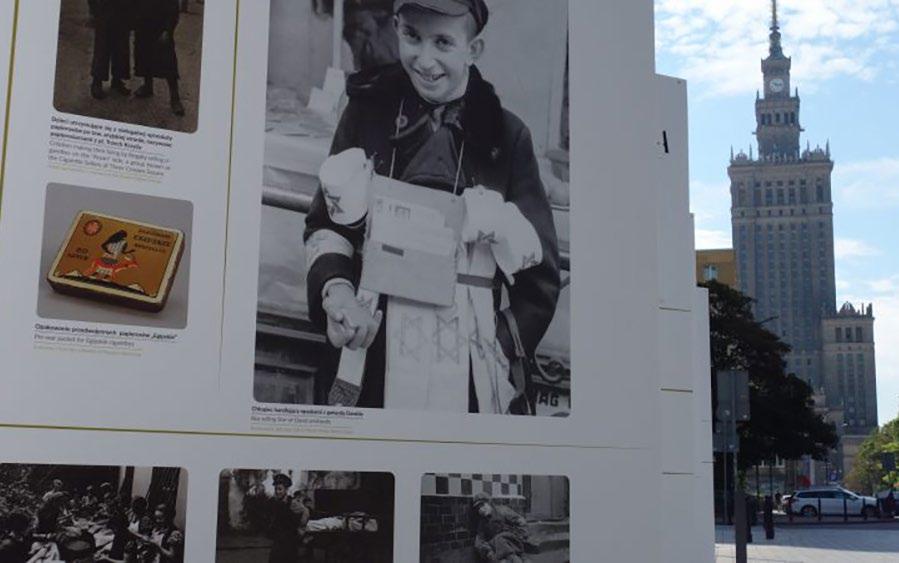
Polish spirit of independence shown through personal stories
The “Generations of Freedom” exhibition in the courtyard of Warsaw’s Royal Castle tells the stories of five Polish families who gave their lives for their country in the last century.
“It’s a small exhibition about great people to whom we owe a free and independent Poland,” said Jarosław Szarek, President of the Institute of National Remembrance (IPN), which organized of the exhibition.
The IPN project honors the memory of the Gwoździewicz, Kulesza, Lazarowicz, Magierski and Majdzik families who fought for Poland’s free dom in various periods of the country’s history.
“The story of undefeated Poland lasted from generation to generation. It was mothers and fathers who passed on our proud, victorious history to their children,” Szarek said. “It was an uninterrupted chain of intergener ational struggles for an independent Poland, the last act of which was ‘Soli darity,’” he added.
The exhibition commemorates three generations of Polish freedom fighters. The first struggled for an independent Poland, in the Polish Le gions, in the Polish-Soviet War and in the 1920 Battle of Warsaw defended it against the Bolshevik invasion. The second fought, in the Home Army, the Polish Underground State, against Nazi Germany and the Soviet Union, during World War II and in the sub sequent resistance against communist enslavement.
The third generation came during the time of the Solidarity struggle in the 1980’s” which paved the way to the col lapse of communism and the rebirth of the Republic of Poland. Until October 4.
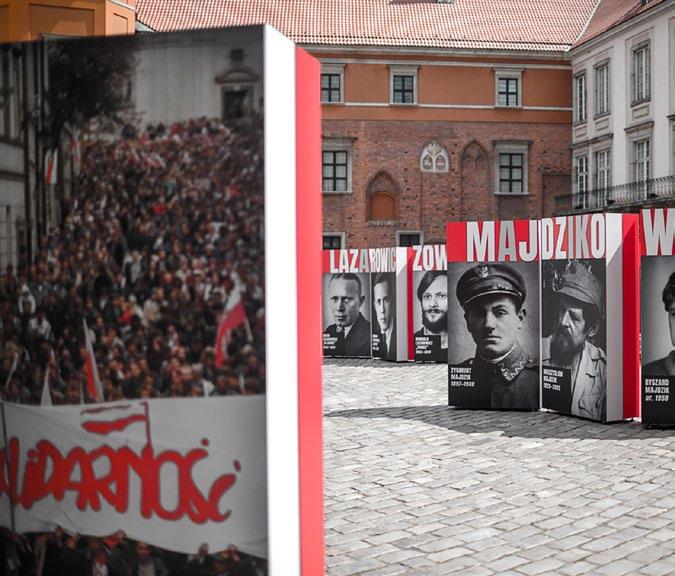
Fragrance for charity
Michał Missala, co-owner of Quality Missala Perfumery stores specializing in luxurious, niche brands spoke about his latest perfume project with the Warsaw Voice.
You co-created ‘Music’, a bespoke fragrance for Poland’s largest annu al fundraising initiative,
known as the Great Orchestra of Christ mas Charity (WOŚP). How did this unusual concept come about?
It was a spontaneous idea. Last year, I met Jurek and Lidia Owsiak, found ers of the Great Orchestra of Christmas Charity foundation at an event where they were receiving another award for their activities. When Jurek found out that my family was involved in the per fume business, he told me he had been thinking of making a fragrance inspired by the Pol’and’Rock festival. This event, billed as the biggest open-air festival in Europe, is organized by WOŚP every summer to thank people for their sup port in the winter public fundraiser. I immediately picked up the topic and had in my head the key notes for the fragrance. Next time we met in our perfumery in Bemowo and we showed them oils from our perfumer’s organ, a palette of ingredients from which fragrances are composed. At that time, we were begin ning to have some idea of the fragrance and prepared a few preliminary propos als for the composition. After a series of further meetings and consultations, one of the proposals was approved by the WOŚP team.
What ingredients were included in the composition accepted?
From the very beginning, I had in my mind those essential notes that had to be included in the fragrance, namely vetiver and patchouli, as they perfectly fit in the whole concept. These are two earthy notes and the Pol’and’Rock brings to mind the smell of trampled on earth, dust, mud and the surrounding nature. Patchouli also has connotations with the hippie generation and the original Wood stock festival, whose continuation the Pol ‘and’ rock festival aims to be. Both ingredient also fit the climate of World Music whose elements appear at the fes tival. Vetiver is associated with the Caribbean and Haiti, patchouli with India and Indonesia.
Other ingredients I had somewhere in the back of my head, though they were not crucial, were black pepper and grapefruit. Pepper was to add a bit of a temperament and grapefruit to ex pose the positive energy of the whole Great Orchestra of Christmas Charity phenomenon. Moreover, as it often rains during the festival, the cooling effect of
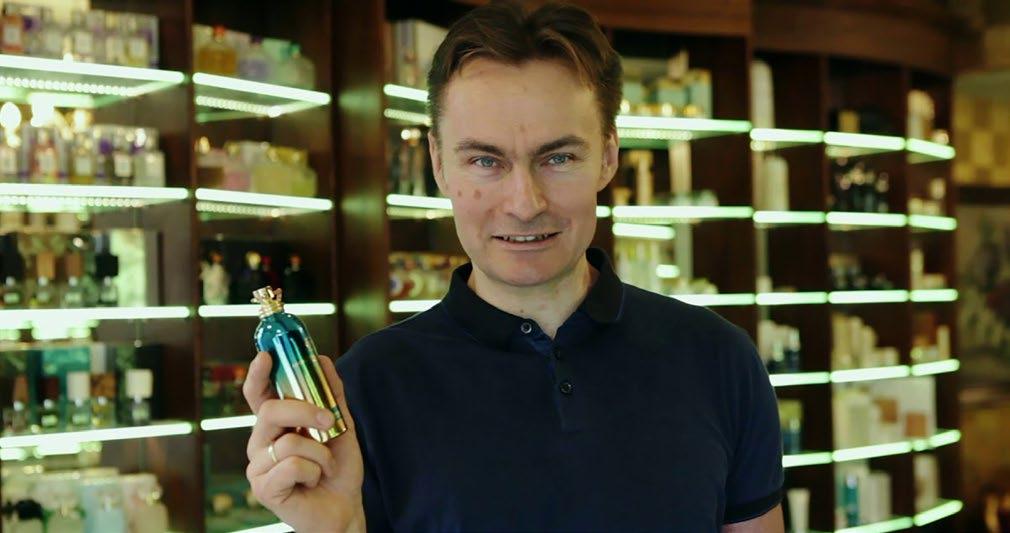
both components highlighted this little nuance in the fragrance. There was also some oud there, but only a little so that it could also appeal to those less experi enced in using niche perfumes.
How did the very process of fragrance creation look like?
I sent the original composition made with our ingredients to a number of per fumers, along with a detailed description of what the perfume should be like, a socalled perfume brief, and a request for three versions. One of them was to be pretty close to our proposal and two oth ers were to be the perfumer’s interpretation of the theme.
When we received the proposals from various perfumers, several of them were taken to the festival and the final choice was made by its participants. The winning sample, which came from a young French perfumer Douglas Mo rel, was in fact the rendition of our original concept. This fact makes me feel the co-creator of this fragrance, whose production version is quite close to the initial composition prepared here, on site. It is worth adding here that the pro duction took place in Poland. So as yet, this is one of the few niche fragrances made in Poland.
As you said before, it was meant as an exclusive fragrance but not solely for connoisseurs.
On the one hand, we wanted it to be a fragrance for young people, but not completely, elegant and niche, but not extremely niche so that it would appeal equally to those who come to the festival and those who want to support WOŚP charity through its purchase in the foun dation’s online store. The fragrance was also intended as a gift for WOŚP part ners and sponsors. As it later turned out, Olga Tokarczuk, who had donated her Nobel Prize replica to a charity auction during last-year’s WOŚP grand finale, got the first flacon.
Who designed the packaging?
The external box is Jurek’s design. Maybe not everyone knows, Jurek has artistic roots and was once involved in the stained glass creation. He wanted the packaging to be fairly simple and unpretentious. One of his ideas was to make the perfume bottle look like a loudspeaker. So we proposed a sim ple cuboid for the shape and suggested to combine a dark bottle with wooden cap. We not only wanted to be modern and eco-friendly by not using plastic but also to refer to the natural environment which is part of the festival’s design. And for the Polish-made fragrance we decid ed to go for Polish wood and chose an oak. As for the other elements, the heart decorating the bottle is the iconic, well known symbol of WOŚP.
Apparently Music is selling well.
As far as I know, most of the first batch has already sold out during the grand fi nale. As we wanted to create high-quality fragrance we didn’t save on the ingre dients. It has a finely-designed composition and a very high concentration of perfume extract, 25 percent. Consider ing its attractive price-tag, I would say it’s great value for money.
Is it true there will be other editions of this likely to be unique world project?
Yes there were such prompts. The name of this fragrance was my idea, inspired by the slogan of the Pol’and’Rock festival - ‘love, friendship & music’. We thought it would be good to start with music, but if more fragrances were to be created then they should also refer to this slogan. So it cannot be ruled out that at least two more fragrances will be made for WOŚP in the coming years.

1 3
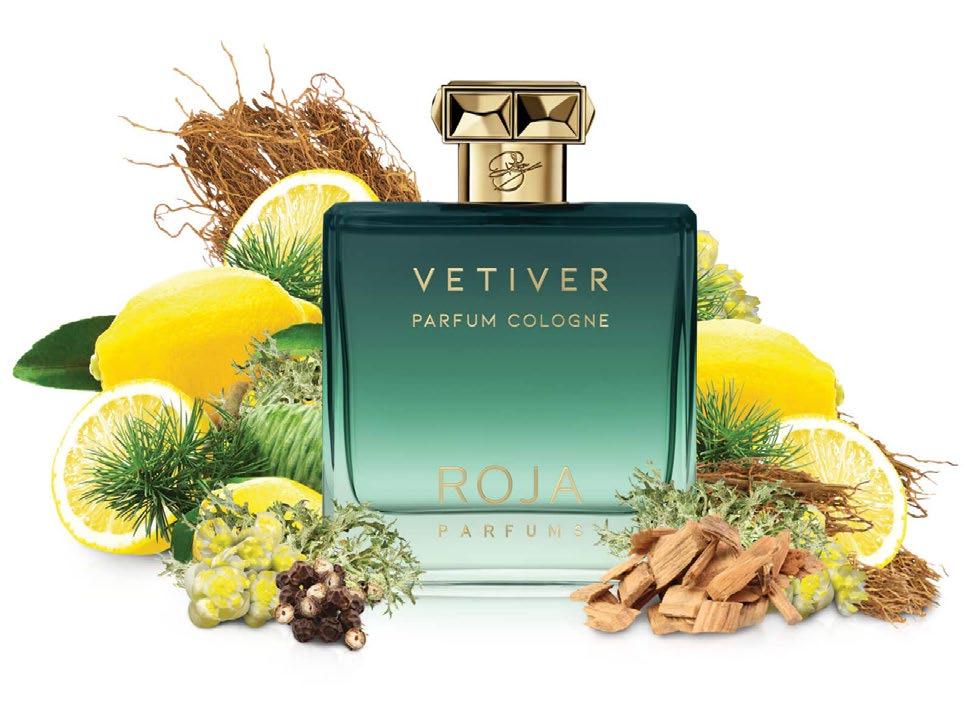
2
1/ Iconic Mood Watch is back An American watch and lifestyle company Fossil has re-launched a chic and modern version of its popular classic model of Mood Watch.
As part of the collectible Archival Series, the watch features the signature color-changing dial and mood decoder based on the wearer’s heart rate. The back of the watch is engraved with each mood color’s meaning. Black stands for anxiousness or excitement, blue green for calmness and relaxation, dark blue for happiness and love, green for sensitivity, amber green for uneasiness, and amber for nervousness.
The classic silhouette stays modern with a look that combines minimalist design and maximum style. It is available in a black-on-black 42 mm steel plated case or 32 mm rose gold-tone case that comes with black leather straps.
Each watch is individually numbered, packaged in a smiley face-covered tin can package. www.fossil.com
2/ Ultimate male scent Vetiver pour Homme is a masculine perfume by Roja Dove.
A warm, dry, fresh, and spicy Chypré fragrance is centered around the sultry smokiness of Vetiver. It is freshened by citrusy green notes such as bergamot, lemon and litsea cubeba, while amplified by a spicy blend of pepper, pink pepper, nutmeg and caraway. Cedarwood and cedar needles are underscored by the dry scent of oakmoss and leather-like cistus and labdanum for a lingering finish. www.missala.pl 3/ Three-dimensional skin pampering Menard Cosmetic Japan has recently released a new version of their COLAX revitalizing serum for face, enhanced with 3D Modeled Collagen with excellent skin absorption. Derived from shark fin and specific cleavage enzymes, this type of collagen is rich in glycinoproline (GP) which increases the filling, firmness and hydration of the skin, giving it a three-di mensionally tightened appearance. It also stimulates natural collagen produc tion and binding.
The formula is enriched with hyaluronic acid to maintain the necessary moisture level of the skin.
For maximum indulging experience, the serum has a luxurious, rich texture and a light and refreshing scent of floral bouquet.










